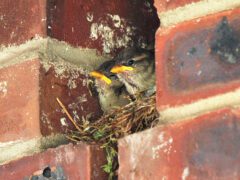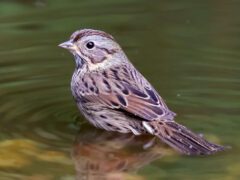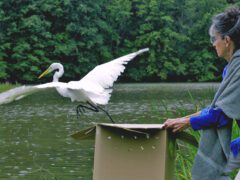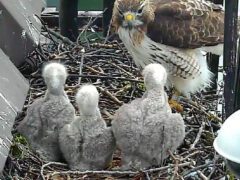Black-backed Woodpecker Similar Species Comparison
Main SpeciesBlack-backed Woodpecker
Male
Medium-sized woodpecker with a solid black back, single white stripe on the face, and barred flanks. Males have a yellow crown patch.
© Luke Berg / Macaulay LibraryOntario, January 29, 2017Female
Medium-sized, mostly black woodpecker with single white cheek stripe and barred flanks. Wings have reduced white spotting. Like the American Three-toed Woodpecker, has 3 instead of 4 toes.
© Bryan Calk / Macaulay LibraryMinnesota, January 13, 2018Male
A medium-sized woodpecker with a long, powerful bill; inky black back; and fine black barring on the flanks. Male has a yellow crown patch, lacking in adult female but present in juvenile.
© Cam Nikkel / Macaulay LibraryManitoba, December 31, 2021Male
Male has a yellow crown patch, solid black back, and barred flanks. Sometimes appears dingy gray on the underparts from feeding on soot-blackened trees.
© Jason Dain / Macaulay LibraryNova Scotia, June 21, 2017Female
Almost entirely black from behind, save for the small white spots on the wings and fully white outer tail feathers.
© Chris Wood / Macaulay LibraryMinnesota, February 03, 2008Male
Best known as a specialist in burned forests, but also forages in unburned forest, particularly on trees infested with bark beetles.
© Benjamin Clock / Macaulay LibraryMinnesota, June 20, 2011Female
Females have a black crown, a white stripe on the face, and barred flanks. Found across the boreal forest and in the mountains of western North America, particularly in recently burned forests where wood-boring insects are abundant.
© Chris Wood / Macaulay LibraryMinnesota, September 15, 2016Male
Unhurried foraging style. Typically stays in one spot for long periods, first stripping away bark and then pecking into wood-boring beetle tunnels to extract the larvae.
© Benjamin Clock / Macaulay LibraryMinnesota, June 20, 2011Male
Often seems to explore for food, stopping to test the bark with a few exploratory pecks to find out whether beetle larvae lie inside.
© Benjamin Clock / Macaulay LibraryMinnesota, June 20, 2011Similar SpeciesAmerican Three-toed Woodpecker
Adult male
American Three-toed Woodpeckers have a barred or solid white back, unlike the solid black back of Black-backed Woodpeckers.
© Andrew Spencer / Macaulay LibraryColorado, May 25, 2016Similar SpeciesAmerican Three-toed Woodpecker
Adult female
Female American Three-toed Woodpeckers have white speckling on their forehead that Black-backed Woodpeckers don't have.
© ROGER GRIMSHAW / Macaulay LibraryNew Mexico, July 01, 2016Similar SpeciesDowny Woodpecker
Female (Rocky Mts.)
Downy Woodpeckers are smaller than Black-backed Woodpeckers with more white on the head and a white patch down the back.
© Chris Wood / Macaulay LibraryColorado, January 10, 2016Similar SpeciesDowny Woodpecker
Female (Eastern)
Downy Woodpeckers have unmarked sides; Black-backed Woodpeckers have barred sides.
© Doug Swartz / Macaulay LibraryColorado, May 15, 2017Similar SpeciesHairy Woodpecker
Female (Rocky Mts.)
Hairy Woodpeckers have a white patch down the back that Black-backed Woodpeckers don't have.
© Jerry Elling / Macaulay LibraryArizona, September 30, 2016Similar SpeciesHairy Woodpecker
Female (Eastern)
Hairy Woodpeckers have unmarked sides, wheres Black-backed Woodpeckers have barred sides.
© David Turgeon / Macaulay LibraryQuebec, January 29, 2017Compare with Similar Species
Click on an image to compare
Species in This Family
Woodpeckers(Order: Piciformes, Family: Picidae)
More to Read
Don't miss a thing! Join our email list
The Cornell Lab will send you updates about birds,
birding, and opportunities to help bird conservation.






























